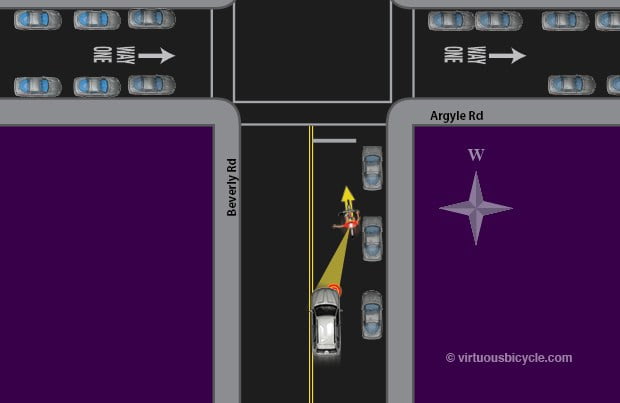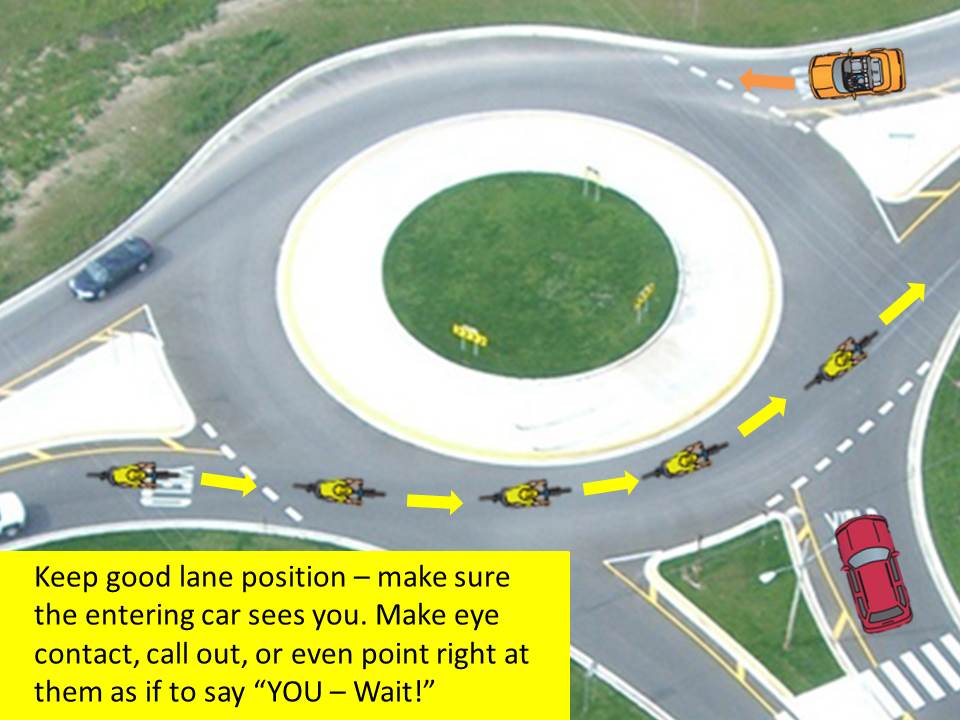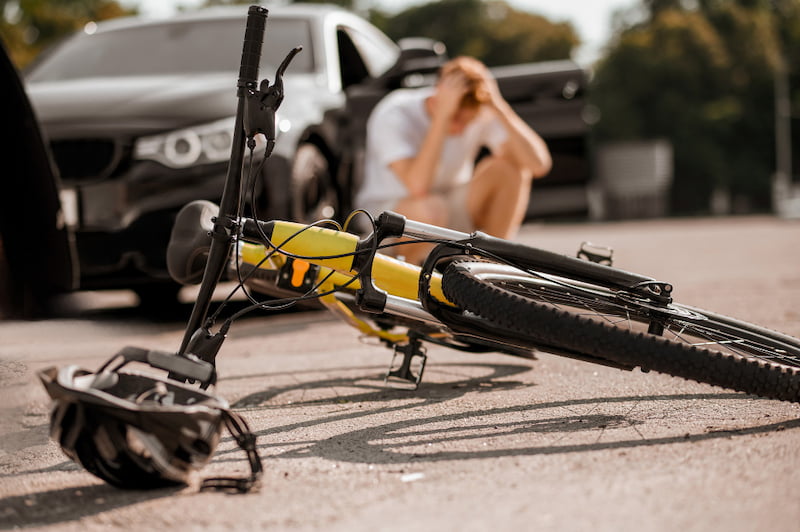This post will explain some typical risky traffic situations for cyclists in traffic and how to avoid them, how to stay safe when cycling on public roads, with other motor vehicles. Each risky situation will be explained separately, with advice how to minimize the risk of an accident.
Before explaining typical situations, list of posts that explain general safety and visibility basics:
- Sorry, I didn’t see you – cyclist traffic safety
how human eye works and how to get drivers’ attention - Bicycle lane positioning and riding in traffic
how to avoid drivers’ “blind spots” - Bicycle lights
why they are important and how to properly “light” a bicycle
Table Of Contents (T.O.C.):
- a) Door zone hit
- b) Right hook
- c) Left cross
- d) Not giving right of way
- e) Dangerous overtake – side swipe
- f) Inconvenience at traffic lights
- g) Sudden (unexpected) situations
- h) Suicidal pedestrians
- i) “Scanning” the surroundings
a) Door zone hit
If you’re riding near parked/stopped vehicles, there’s a chance someone will open a door to get out.

Even if a car appears empty when looking inside through windows, there’s still a chance a child, or a short person will open a door to get out.
Solution is simple: stay away from the door zone.

Special scenario is filtering between vehicles. For this to be safe, all the following conditions need to be satisfied:
- The vehicles should be stopped. Filtering between moving vehicles on a bicycle, even if they’re moving slowly, isn’t very safe. It can be done, by an experienced cyclist on a road they know well, know drivers’ habits, but even then it’s a bit risky.
- Cyclist should move slow enough to be able to look inside each vehicle’s cabin. Is someone going for the door? Are front wheels turning so a vehicle might move towards you? Is a driver checking their mirror on your side – they might be planning to move in that direction.
- Hands always ready at the brakes and speed slow enough so you can stop instantly.
- If anything happens, you should be prepared to take all the legal, material and moral consequences and responsibility, if such a manoeuvre (i.e. filtering) is not legal in your country.

Be cautios, patient and always bear in mind that a second of rush can be very costly.
b) Right hook
Classic situation: a bicycle goes straight, a car turns right over it.

A car turns right, cutting across cyclist’s path, potentially knocking them down/running over
How to avoid it? When approaching a junction (or a parking lot) where cars can turn right, check over the shoulder if a car is overtaking you at the moment. Be ready to brake if they start turning right. Safer style is to check for oncoming traffic at a larger distance before a junction and, when it is safe, move towards the middle of the lane. Such lane positioning makes drivers much less likely to try the risky right hook manoeuvre, and if they do, there’s more room for “running away” and braking.
Scenario one, no cars approaching:

There are no cars approaching from behind, it is safe to move towards the middle of the lane and cross the intersection.
Second scenario. Vehicle approaching. This is why it’s important to look ahead and change lane position in time.


Here is a classic right hook scenario, when the cyclist doesn’t change their lane position in time:

Sticking all the way to the right, got themselves in a right hook situation.
In the picture above, while the car is overtaking the cyclist, just before the turn, the cyclist is in the car’s blind spot. Blind spots are explained in this post: Bicycle lane positioning and riding in traffic. In addition to the right hook risk, the cyclist in the picture above is also riding in the door zone, and while the car is overtaking, the cyclist has no room to escape in case some of the parked cars starts to move to the left, into the lane (or someone opens a door) – multiple risks.
If there’s a bicycle lane on the right side of the road, pay attention to cars slowing down – they are likely to turn right, or try to park. Stay behind them and be prepared to stop if they turn in front of you and pull over, or turn. Even if they’re signalling a left turn signal, they might turn slightly to the right, before making a u-turn – many drivers do that.

If there’s a car in front slowing down, best not to move by it in the bike lane, but slow down behind it, waiting for it to turn, park, see what they’ll do…
The same goes for roundabouts:


c) Left cross
When a bicycle is hidden behind a car in front, there’s a higher chance a car coming from the other way, turning left, will turn at the cyclist.

Car in front is blocking the view of the cyclist to the oncoming car turning left.
Even when not hidden by a vehicle, a bicycle can be hardly visible by a low sun shining behind it, or by staying in the right most part of the lane, where a driver coming from the opposite direction isn’t expecting vehicles to appear (most drivers look for other cars in the middle of the lane).
Way to avoid this is by proper lane positioning, or allowing for more distance behind a vehicle in front. If there are no vehicles, swerving from right to left within one’s lane is a good way to draw attention of other drivers approaching an intersection.

Bottom picture – bicycle is visible
d) Not giving right of way
Situation when other vehicles don’t give a bicycle the right of way. Usually happens because of too little lateral movement. Simple way to avoid this:

Make sure to check whether vehicles are approaching from behind, to avoid a dangerous move in front of an approaching vehicle!
Phenomenon of cyclist visibility and lateral movement is explaine in this post: Sorry, I didn’t see you.
e) Dangerous overtake – side swipe
A car starts to overtake a cyclist. It turns out there’s not enough room for a safe overtake. When a driver must choose between a collision with an oncoming vehicle and the bicycle they are overtaking, they often choose the latter.

How to avoid this? If there’s not enough room for a safe overtake, either move off the road, or take the lane – making vehicles behind wait for a better time to overtake you.
Lane must be taken in time. One mustn’t just “jump” in front of an approaching vehicle. Check first over the shoulder, make sure the driver behind has enough time to notice your change of lane position and slow down. Only when it is safe, in time, make a move to change the lane position and “take the lane”.
The greater the speed difference between a bicycle and oncoming cars, the more cautiously and earlier this manoeuvre needs to be taken. If, for example, a road is used often by heavy lorries that need more time to slow down and there’s a bend behind you, making it impossible for the lorry driver to spot you in time, and the vehicles go fast on that part of the road, this manoeuvre can be dangerous. So use taking the lane cautiously and with good judgement. It’s not always the safest option, although it most often is.
f) Inconvenience at traffic lights
If a bicycle is stopped first at a traffic light, the cyclist is sure to learn the definition of a millisecond: the time that passes from the traffic light turning green, to the first car horn. 🙂 Best way to avoid this is to let one car be in front. Stay second, behind a leading car. If there are no cars at a red light, stay some 10 meters behind the junction, to the right, letting the first car coming to the red light to stay in front.
Staying behind the first car has several benefits:
- No one will honk the horn – you’re not the one setting the pace, it’s the leading vehicle.
- Draft of the vehicle in front is used for easier acceleration. 🙂
- Vehicles running a red light from across are most likely to hit the first vehicle entering the intersection.
g) Sudden (unexpected) situations
A bit vague, general term. What does it mean? When riding always plan some 15 seconds ahead: is a traffic light red, has it just turned green, is there a jam in a traffic lane etc. Plan speed and lane positioning according to what you’re anticipating. Always try to “read” other riders, drivers, pedestrians.
A good, safe driver is the one that can compensate for other driver’s mistakes. Some general tips:
- Whenever possible, check inside the cabins of vehicles that are near. Is the driver talking on their mobile phone? Are there small children inside, distracting the driver? Such drivers are not likely to signal turns, check their mirrors, pay attention in general. Keep a safe distance and expect the unexpected. 🙂
- On a road with more than one lane, while riding in the right lane, if there’s a jam in the left lane, expect a driver to suddenly move to “a gap” in the right lane, often just as you are approaching. Stay as far right as safe (but not in the door zone) and keep your hands ready on the brakes.
- If you are near a bus stop, with a bus approaching, or already stopped at it, expect pedestrians running for the bus from unexpected directions, without looking.
- When an emergency vehicle, with rotating lights and sirens, approaches, some drivers might make silly moves. Move off the road safely and wait for it all to pass.
- When a traffic light turns red (blinking green, or a yellow), some drivers step on the throttle. If you’re stopping, check whether it is safe, or you need to move to the right and clear the road.
- When going around, or overtaking other vehicles, leave enough room (moving further to the left) so there is time for avoiding/braking in case a vehicle starts to move to the left, or a driver empties an ash tray just at that moment etc…
- Never make sudden moves – always make sure that you and your moves are predictable to the others.
h) Suicidal pedestrians
Like rain: uncomfortable, but often present. Pedestrians tend to jump suddenly in front. If there’s a pedestrian near, always be prepared to brake, or avoid. Check over the shoulder for oncoming cars. If there are some, then the only manoeuvre left is braking. Many have earphones and aren’t looking, so there’s no use relying on them to be careful. Try reading their intentions, make sure to spot them in time and have a backup plan in case they just move into your path.
If you are surprised by a pedestrian you didn’t see in time, “jumping” in front of you, and there’s no time to stop, the only option is avoidance. That is why it is important to check for oncoming traffic behind regularly. So you know whether it is safe to swerve, and in which direction. If a pedestrian that has jumped in front of you sees you at the last second, you can expect that most men will jump forward, while women will stop, or make a step back. Most often. Of course, if your instinct tells you otherwise, listen to it.
In my experience, when they see (notice) you at the very last second, women tend to make a step/jump back, while men tend to jump/rush forward. At least 90% of the time (there are rare exceptions). I try to not have to rely on this, but when the unexpected happens, that’s something I take into consideration.
i) “Scanning” the surroundings
The last, but not the least important – when riding, always scan the entire surroundings. Never focusing on one particular danger for long. For example, keeping focus on a car to the left can cause one to not notice another car approaching from the right at the same time. With a tic-tac principle – quickly switch focus from one to the other danger, always observing the entire surroundings. From close, to further, than back.

With a tic-tac principle, the focus “jumps” from one “danger” to the other.
Once a rider gets tired, one of the first things that give is the focus change speed – eyes remain fixed to a certain objects for longer, which increases the risk of overlooking a danger. That is why conscious effort should be made to keep actively scanning the surroundings all the time, without keeping focus for too long on one object.


very well written!